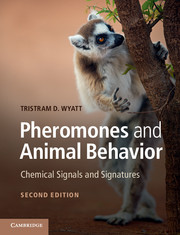Book contents
- Frontmatter
- Dedication
- Contents
- Preface to the second edition
- Acknowledgments
- List of SI prefixes
- List of Abbreviations
- 1 Animals in a chemical world
- 2 Methods for identifying and studying semiochemicals
- 3 Pheromones, chemical cues, and sexual selection
- 4 Coming together and keeping apart: aggregation pheromones and host-marking pheromones
- 5 Territorial behavior and semiochemicals
- 6 Semiochemicals and social organization
- 7 Pheromones and recruitment communication
- 8 Fight or flight: alarm pheromones and cues
- 9 Perception and response to chemical communication: from chemosensory receptors to brains, behavior, and development
- 10 Finding the source: pheromones and orientation behavior
- 11 Breaking the code: illicit signalers and receivers of semiochemicals
- 12 Using semiochemicals: applications of pheromones
- 13 On the scent of human attraction: human pheromones?
- Appendix An introduction to chemical terms for non-chemists
- References
- List of Credits
- Index
4 - Coming together and keeping apart: aggregation pheromones and host-marking pheromones
Published online by Cambridge University Press: 05 June 2014
- Frontmatter
- Dedication
- Contents
- Preface to the second edition
- Acknowledgments
- List of SI prefixes
- List of Abbreviations
- 1 Animals in a chemical world
- 2 Methods for identifying and studying semiochemicals
- 3 Pheromones, chemical cues, and sexual selection
- 4 Coming together and keeping apart: aggregation pheromones and host-marking pheromones
- 5 Territorial behavior and semiochemicals
- 6 Semiochemicals and social organization
- 7 Pheromones and recruitment communication
- 8 Fight or flight: alarm pheromones and cues
- 9 Perception and response to chemical communication: from chemosensory receptors to brains, behavior, and development
- 10 Finding the source: pheromones and orientation behavior
- 11 Breaking the code: illicit signalers and receivers of semiochemicals
- 12 Using semiochemicals: applications of pheromones
- 13 On the scent of human attraction: human pheromones?
- Appendix An introduction to chemical terms for non-chemists
- References
- List of Credits
- Index
Summary
Aggregation pheromones lead to the formation of animal groups near the pheromone source, either by attracting animals from a distance or stopping (“arresting”) passing conspecifics (Chapter 10) (Wertheim et al. 2005). In contrast to sex pheromones (which attract only the opposite sex), aggregation pheromones by definition attract both sexes (and/or, possibly, larvae). However, the benefits of aggregation to individuals may be complex and two rather different mechanisms may apply. First, individuals may be aggregating for the benefits of living in a group. Second, what we call aggregation pheromones may be the response of eavesdropping conspecifics, for example males responding to sex pheromones released by other males to attract females, in order to mate with those females (Chapters 3 and 11).
By contrast, host-marking pheromones deposited on hosts by insects parasitizing fruits or caterpillars, for example, lead to dispersion as host-marking pheromones deter other females from laying eggs in that host. How host-marking pheromones evolved is discussed in Section 4.2.
- Type
- Chapter
- Information
- Pheromones and Animal BehaviorChemical Signals and Signatures, pp. 105 - 112Publisher: Cambridge University PressPrint publication year: 2014
- 1
- Cited by



